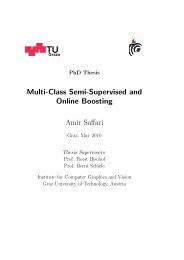PhD Thesis Semi-Supervised Ensemble Methods for Computer Vision
PhD Thesis Semi-Supervised Ensemble Methods for Computer Vision
PhD Thesis Semi-Supervised Ensemble Methods for Computer Vision
You also want an ePaper? Increase the reach of your titles
YUMPU automatically turns print PDFs into web optimized ePapers that Google loves.
5.2. On Robustness of On-line Boosting 65<br />
Algorithm 5.1 On-line <strong>Semi</strong>Boost<br />
Require: A training sample: (x n , y n ) ∈ X L or (x n ) ∈ X U .<br />
Require: Prior knowledge: F P<br />
Require: Number of selectors M.<br />
Require: Number of weak learners per selector K.<br />
1: Set the initial weight λ m = e −yF (0) = 1<br />
2: <strong>for</strong> m = 1 to M do<br />
3: // Update weight estimation<br />
4: if (x n , y n ) ∈ X L then<br />
5: y m = y, λ m = e −yF m−1(x)<br />
6: else<br />
7: // Update pseudo label and weight<br />
8: ˜z m (x) = tanh(F P (x)) − tanh(F m−1 (x))<br />
9: y m = sign(˜z m (x)), λ m = |˜z m (x)|<br />
10: end if<br />
11: <strong>for</strong> k = 1 to K do<br />
12: Train k th weak learner fm(x) k with sample (x n , y m ) and weight λ m .<br />
13: Estimate the error:<br />
14: if fm,k<br />
weak (x) == y then<br />
15: λ c m,k = λc m,k + λ k<br />
16: else<br />
17: λ w m,k = λw m,k + λ k<br />
18: end if<br />
19: e k m = λw n,m<br />
λ c n,m+λ w n,m<br />
20: end <strong>for</strong><br />
21: Find the best weak learner with the least total weighted error: j = arg min<br />
k<br />
22: Set f m (x n ) = f( m(x j n ). )<br />
23: Set α m = 1 ln 1−e m<br />
2 e m<br />
24: end <strong>for</strong><br />
25: Output the final model: F (x)<br />
e k m.<br />
This re-weighting strategy allows boosting to concentrate on hard samples while easy<br />
samples are less emphasized. However, if the sample has a wrong label and the previous<br />
weak learners are assigning the true (but hidden) label to the sample, AdaBoost still will<br />
consider this as a mis-classification and dramatically (exponentially) increase its weight.<br />
This can finally corrupt the learning result. There<strong>for</strong>e, the per<strong>for</strong>mance of the boosting<br />
algorithm will be highly dependent on the presence of such noisy samples.



